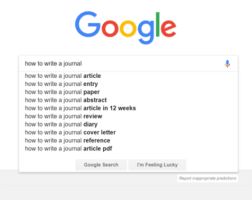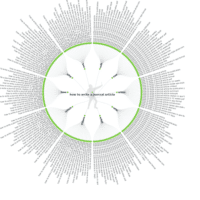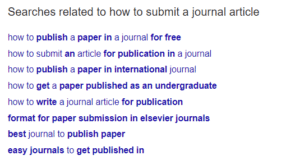How to improve the discoverability of your journal with SEO
How do people find the research published in your journal? How do you make sure the right people, find the right articles at the right time? One obvious answer is search engine optimization (SEO).
SEO is a set of techniques you can use to make sure search engines, like Google, can read and understand your journal content. This means they can then serve it as a highly ranked search result for relevant queries.
This post takes a simple look at how search engines work and takes you through some easy ways to improve the discoverability of your journal with SEO.
How do search engines work?
Increasingly, when people want information or answers, they turn to search engines. Those search engines, in turn, want to give visitors the most accurate and useful results for their search term and intention.
Search engines don’t automatically know what’s on every web page and online document though. Instead they use crawlers to look for keywords, links, and certain codes on a webpage. This information tells the search engine:
- What an article is about
- What questions it answers
- How it’s structured
- And what type of resource it is.
It is therefore up to you and your publisher to make sure those crawlers have access to as much accurate information about your journal and its articles as possible. That way, your research will appear high up the search rankings for the relevant queries.
Search engines also look for signs that the information you give is credible. They have lots of ways of assessing this, including how many links exist from other credible sites to your article or journal. This means spreading the word about your journal has a bigger impact than you think.
How does Taylor & Francis improve the discoverability of your journal with SEO
Taylor & Francis is constantly working to ensure that Taylor & Francis Online is search engine optimized at site level and to improve discoverability of the articles published in our journals.
We allow all search engines to crawl Taylor & Francis Online to accurately index our articles and provide more accurate search results for users. And our linking program extends to many abstracting and indexing databases, library sites, and through participation in CrossRefTM. Find out 5 ways Taylor & Francis maximizes the reach of research.
But there’s only so much we can do. Some of the work sits with authors and journal editors, to provide the right keywords and increase links from other reputable sites to the journal.
How you can improve the discoverability of your journal with SEO
There are two main ways you can improve the discoverability of the research in your journal.
- The first is through encouraging best practice among your authors in how they choose their title, abstract, and keywords.
- The second is building up backlinks to your journals from a range of relevant and credible sources.
How to write a search engine optimized title
Researchers might be tempted to use “clickbait’ tactics to get people to read their article. This means using sensational language or popular culture references in their title. And it might work to get a lot of clicks, but it doesn’t work for improving engagement or boosting SEO.
A title sets expectations for what someone will get from an article when they click through to it. If that title doesn’t accurately reflect the content, visitors will be frustrated and click back to the search engine. This tells the search engine that the article is not a good resource for the visitor’s search term. And the more this happens, the lower the search engine will place that article for similar searches.
For research to come up in relevant searches, the title needs to be clear and accurately reflect the article. This way the right people will visit the research and engage with it, rather than clicking back to the search engine.
How to optimize abstracts and keywords for search engines
As with titles, when authors are writing their abstract and selecting their keywords, they need to think carefully about reader expectation. Authors must always aim to accurately describe their research, but at the same time, try to do so in terms that are familiar to their target audience.
Get authors to think about your journal audience. Help them understand:
- The search queries that audience are likely to be entering
- Why they would be searching for research
- And how they identify relevant research
Absolutely make sure that all authors submit a full set of keywords with their research. This makes them more discoverable both on search engine and on Taylor & Francis Online.
Finally, remember that titles must be in “natural language” and must accurately describe the content. Filling titles and abstracts with keywords to improve search engine rankings is likely to get you blacklisted and the article could be removed from all search results.
How to research keywords relevant to your journal
- Define your audience. Understand your ideal journal reader. What fields do they work in? How would you describe their pain points? What are they hoping to achieve? Where do they get their information from? What kind of language do they use?
- Define your audience’s needs. To rank highly in search engines, your journal content needs to be relevant, authoritative, and trustworthy. This goes back to your Aims and Scope and ensuring that the kind of research you accept meets the needs and research interests of your target field(s). From there, you can start to understand the type of questions and terms your audience will be searching for.
- Research keywords and phrases using free online tools. There are lots of tools available that tell you what terms people are looking for, related terms, and questions. These include:



Related searches

People also ask
There are also tools, like Ubersuggest, that tell you the search volume – the number of people on average who use that search term each month – and how much competition there is to rank for that term.
For example, “cancer therapy” is a very broad term that a lot of journals and other websites and organizations will be competing for. A more specific term, however, such as “immunotherapy for breast cancer”, will have less competition and a more relevant audience searching for it.
How to build up backlinks to your journal
Links from other credible websites to your journal play an important role in improving search rankings.
Search engines assess many factors to determine the quality of the links to the research published in your journal, including:
- Trustworthiness
- Traffic
- Relevance
- And link text, among others.
To encourage the right kind of backlinks, add the journal to your departmental website, blog, or personal webpage and encourage your authors to do the same.
Better still, if you know someone who writes a blog in your field, ask them to write a post about research in your journal. Or offer to write a guest post for their site. Don’t forget to add a link to the research. And use the link text to your advantage – hyperlink phrases like “Read my article on cats” instead of “click here.”
Other ways to increase the visibility of your journal
YouTube is the second most widely used search engine in the world: if you or your authors are keen vloggers, link to the journal articles in your video comments. Remember that as with article titles, this must look like natural language, e.g., “Read my article on cats online: www.tandfonline.com.”
Tweeting or posting on Facebook about research published in your journal can directly increase the number of downloads for individual articles. This helps search engines make another connection between the link to your research and the search queries they are attempting to fulfill, although this has become a less influential factor in recent years.
A more effective use of social media for SEO, is using it to see who’s talking about the research in your journal. Take a look at the Altmetric data on the article pages on Taylor & Francis Online. If you find someone influential, with their own credible website, reach out to see if you can foster a useful backlink.
Get your journal mentioned in the press
News stories linked to academic research can significantly increase discoverability of individual articles and raise public awareness of your journal. Research published in Taylor & Francis journals has been featured on television, in print, and online and led to worldwide recognition of key academic research.
If you spot an article that you think would make a good news story, get in touch with your marketing contact about whether they think there is potential for a press release or suggest that the authors contact their university press office.
Seeing the results of SEO
The final thing to remember is that SEO takes time. You can’t predict when a search engine will next crawl your journal pages, or website where you have built backlinks. It is a slow and steady task, but one which pays off when done consistently and done right.